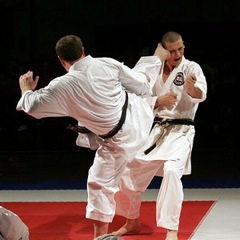KUMITE
Kumite is a catch-all expression roughly translated as "fighting". Though many people see Kumite as the be all and end all of Karate it is just one facet, and arguably the least important one at that.
Ninety-nine percent of people take up the martial arts for the self defence aspect but, as time progresses, they learn that there are many other benefits to be gained from martial disciplines and that the fighting is just one way of developing them.
We have different forms of Kumite ...
- Ippon Kumite - One Step Fighting
- Jiyu Ippon Kumite - Free One Step Fighting
- Jiyu Kumite - Free Form Fighting
- Shobu - Competition
Ippon Kumite - One Step Fighting
This is a very formalised type of fighting, which consists of predetermined attacks, blocks and counter strikes. The movements are set in the syllabus, and each new belt attempted requires a new set of Ippon Kumite increasing in number and complexity as the student progresses through the grades. For example, a beginner would be asked to execute three "ippons" such as using a rising block and a counter punch to the body in response to a face punch; a black belt would perform twelve "ippons" including a throw from a wrist lock as a counter to a body punch.
All students from a beginner taking his first belt to senior grade taking 3rd Dan will perform Ippon Kumite as part of their grading requirements. The heart of Ippon Kumite is that the attacks are all performed full force and in range (you cannot perform an effective defence against an attack that is not going to hit you); the defence must be effective (it soon becomes obvious if you have not learned them well enough!) and the counter should be controlled but capable of disabling your opponent with a single blow if it was delivered "with intent". You are also not allowed to move backwards, you must face the attack or side step it (good training for spirit, and those moments when you have your back against a wall).
Jiyu Ippon Kumite - Free One Step Fighting
Similar to Ippon Kumite, and a grading requirement for higher grades, Jiyu Ippon Kumite consists of the attacker either ...
being given a set attack (e.g. side kick) which is delivered in any form or variation of the technique to any viable target on the body, and the defending student has a free choice of block and counter. Each time the attack is thrown the defender is expected to perform a different block/counter combination.
... or ...
the grading examiner will determine the target areas (e.g. four head attacks, followed by four body attacks, then two low level attacks) and the attacker can attack with any technique as long as it is to the specified area. Again, the defender has a choice of defence and counter but is expected to show a range of techniques.
Jiyu Kumite - Free Form Fighting

A black belt will tone down his or her sparring when faced with a less able partner and give them a chance to land a technique - the less experienced karateka are encouraged, not beaten to death. Jiyu Kumite is a learning experience first and foremost, a chance to try out new techniques in relative safety, a way to develop and maintain specific reactions or dominant responses. And have some fun!
Shobu - Competition
Karate will be an Olympic Sport in 2020 and sport karate follows very precise rules which cross all boundaries of style, association or club. In short, competitors wear either Ao (blue belt) or Aka (red belt), and a referee starts and stops the bout, and awards points for well executed techniques. Very simply, head level kicks and takedowns (with an immediate finish) score more than basic punches or hand strikes. At the end of the three minutes the fighter with the most points wins.
This is a very technical form of fighting, and involves tactics and skill in preference to brute force and ignorance. Shobu competition requires specialised training, and is not appropriate for all Karateka.
All forms of fighting test the body to it's limits. You work muscles and joints in strange and unusual ways, your mind has to be focused and clear and, at the end of the day, it's a great way to work out all those frustrations, niggles and hassles of every day life that just seem to keep piling on top of you.
Have you ever wondered why people who train seriously in the martial arts for many years are so calm and laid back?
Many people are under the impression that you cannot use karate to defend yourself without running foul of the law. This is a myth, as is the belief that a karate practitioner has to register his hands and feet with the Police as "deadly weapons".
The paradox of Karate is that we learn to fight so we don't have to. Given the choice, any true martial artist will walk away from a potentially violent situation. Only as an absolute last resort will a true martial artist engage in physical violence.
The Law says that you may use reasonable force to defend yourself or your loved ones. What this means is that if an aggressor tries to punch you then it is reasonable to punch that person back to protect yourself. If however you continue to punch, kick or otherwise pummel your attacker beyond the minimum that is required to end the conflict then you may find yourself in court facing assault charges.

Should this happen you will find the legal system less than sympathetic. Not because you are a "trained killer whose whole body is a deadly weapon", but because as a martial artist you should know when to stop.

